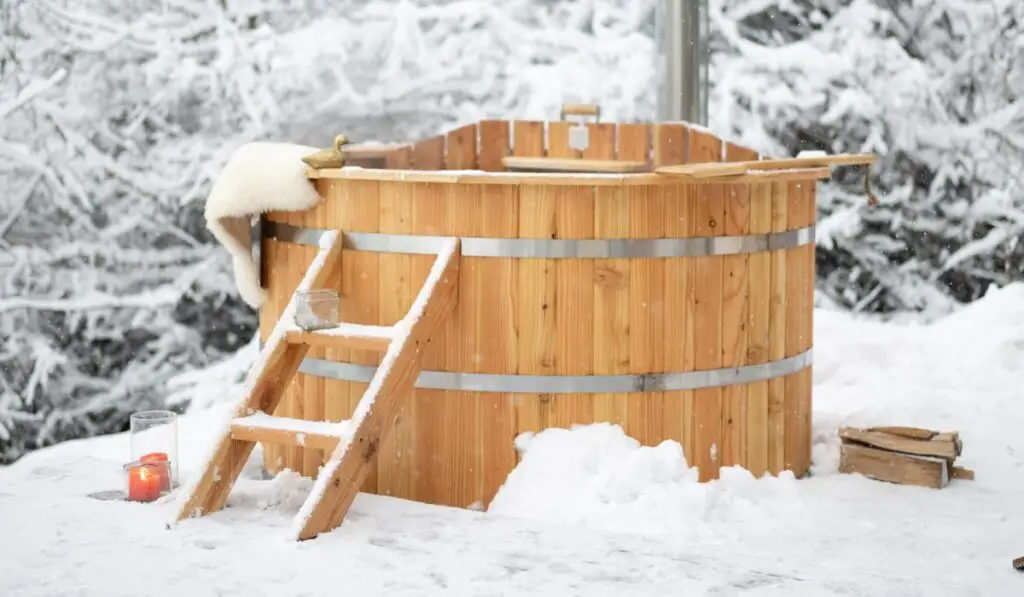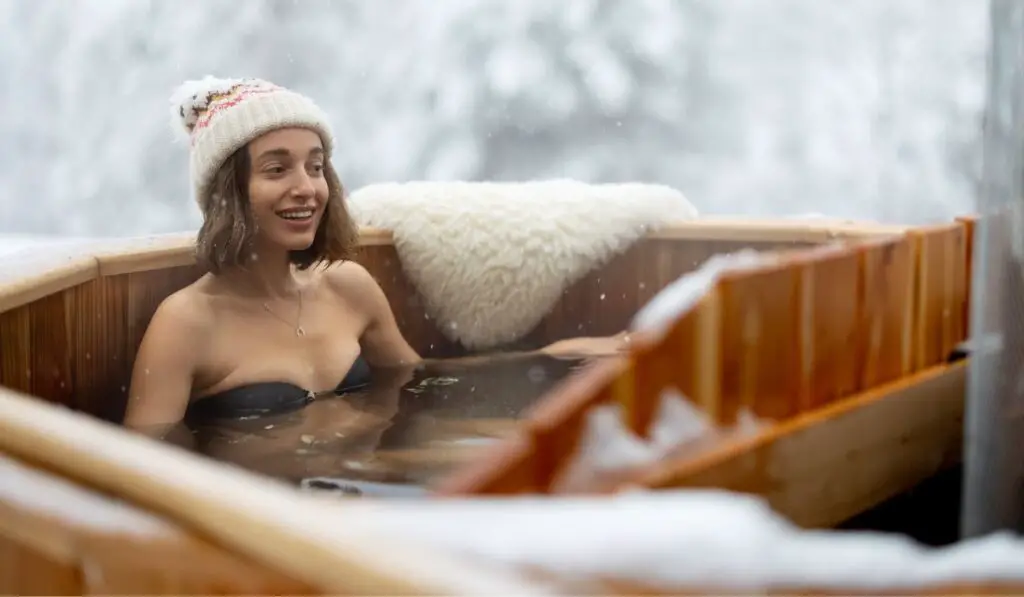Whether you’re a hot tub owner or considering installing one, you’re not just thinking of how lovely it would be to soak in the tub on a snowy day but also about how the winter’s freezing temperatures might affect the cost of running it.
The cost comes down to the size of your tub and energy prices in your state or region. In Alaska, for example, you’ll pay 24.25 cents per kWh. It’ll take 166,600 BTUs (equal to 48.8 kWh) to heat a 400-gallon hot tub from 50℉ to 100℉. So, it’ll cost you $11.83 to heat your hot tub from 50℉ to 100℉.
Unless your hot tub is solar-powered, the costs of running your tub when the temperatures drop should be a matter of concern. Fortunately, there are many ways to lower your hot tub’s operating expenses in the winter. So let’s jump right in and find out everything in detail.
What is the Average Cost of Running a Hot Tub During the Winter?

To find out exactly how much it will cost to run a hot tub during the winter, you’ll first need to know how much you usually pay per kilowatt-hour (kWh). When calculating this cost, consider that energy prices vary significantly by state and region.
According to the US Energy Information Administration (EIA), as of July 2022, residents of Alaska paid 24.25 cents per kWh, while residents of Nebraska and North Carolina paid 12.03 cents per kWh.
Using that information, you can determine how much kWh it takes to heat your hot tub. To do this, you need to figure out how much energy it takes to heat the number of gallons of water in your hot tub.
Given that it takes 8.33 British thermal units (BTUs) to heat a gallon of water by 1℉, if your hot tub holds 400 gallons of water, it will take 166,600 BTUs to heat it from 50℉ to 100℉.
Since 166,600 BTUs is equivalent to 48.8kWh, meaning that if you’re paying 24.25 cents per kWh in Alaska, it will cost you $11.83 to heat your tub from 50℉ to 100℉.
When the weather gets colder, it will cost you a bit more to get the water temperature to 100℉ because you’ll start from a lower temperature. However, that little math exercise should be enough to give you a rough estimate of how much it will cost you to run your tub during the winter.
And remember, to measure or know any of this properly, you may want a simple floating thermometer like this one (on Amazon) to use to make sure you can measure the temperature in a consistent way.
What Temperature Should Your Hot Tub Stay at During the Winter?
The ideal temperature for a hot tub during the winter is between 102°F and 104°F. This temperature isn’t fixed, though.
You may need to lower it to ensure a safe and relaxing soak if the doctor recommends you do so for your health or if a child or pregnant woman is using the tub.
How to Properly Maintain a Hot Tub During the Winter
Proper hot tub maintenance is essential, especially during the winter. Here’s how to go about maintaining it:
Clean the Hot Tub
Whether you use your hot tub daily or only once in a blue moon, you need to regularly drain and clean it to avoid murky hot tub water and keep it healthy for bathers. As you clean your hot tub, be sure also to clean the filter.
You can use a regular filter cleaner or leave it in a chemical soak overnight if it’s filthy.
Invest in a Hot Tub Cover
Get a high-quality hot tub cover to prevent snow and leaves from getting into your hot tub. If too much snow accumulates on the cover, don’t use a shovel to get it off, as you may end up ripping the cover. Rather, sweep the snow off using a broom.
Shock the Hot Tub
You should shock your hot tub at least once per week using chlorine or non-chlorine shock (on Amazon).
Shocking your tub doesn’t just clean and clear the water. It also kills bacteria in the tub, making it safe for a nice warm dip. Additionally, shock treatments reactivate sanitizers and eliminate waterborne organic compounds that standard sanitizers struggle to remove.
How to Reduce Hot Tub Costs During the Winter

There are several ways to reduce the cost of running a hot tub during the winter. They include:
Get a Good Cover
On average, 60% of the water’s heat escapes from the surface. Therefore, investing in a high-quality, thick, tight-fitting hot tub cover is your best bet to immediately cut down on operating costs in the winter months.
The thicker and denser the cover, the better it will be at curbing heat loss. Moreover, get a hot tub cover that wraps around your tub’s rim instead of just lying on top, as it will be more effective at retaining heat.
Add a Hot Tub Thermal Blanket
Investing in a hot tub thermal blanket is another great way of reducing operating costs. The blanket sits directly on the water but beneath the cover, allowing more heat to stay inside the tub.
This additional layer of protection significantly lowers your hot tub-related utility costs. Moreover, hot tub thermal blankets are lightweight and easy to clean.
Keep Your Hot Tub Clean
Maintaining your hot tub well and ensuring it’s clean with proper chemical levels in the winter won’t just be healthy for you but could also help keep the operation costs low.
A dirty hot tub with mucky filters makes the system work harder and longer, increasing the electric bill and even leading to premature tub failure or damage.
Install an Insulating Base Pan
As it turns out, one of the easiest ways to lose heat is through direct contact with the ground. During the winter, the ground can leach away large amounts of heat from your hot tub. You can add a base pan to your hot tub to prevent this heat loss.
A base pan sits between the hot tub’s bottom layer and the ground, creating an extra thermal barrier that prevents heat from escaping into the ground. As a result, hot tubs with base pans are usually far more effective at preserving heat and thus cost less to run in the winter.
Close the Air Jets
Air jets make the water churn, helping your body and muscles relax. So, keeping them open while using the hot tub is generally preferable. However, experts recommend you close them when you’re not using the hot tub to prevent cool air from getting into the system.
The cold air cools the water, causing your heater and pump to work harder to replace the heat that the hot tub loses. Consequently, you’ll notice an increase in hot tub energy use.
